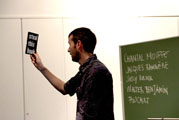- CA2M MUSEUM
- Activities
- WHAT ARE THE OBJECTS TELLING US?
WHAT ARE THE OBJECTS TELLING US?

One of the most powerful art capacities is the transformation of our look towards the objects of our world. In this regard, many artists concentrate their practice in the activation of objects apparently trivial in order to trigger new narratives which go beyond a positivist materialism, thus, they deny any reality whenever it appears reaffirmed in an excessive manner.
These creative acts are focused on generating new forms of relationship with our surrounding, whether by using appropriationist strategies of Duchampian influence, others closer to surrealism of found objects, or whether by those strategist from détournement of the Situationists. Then, it´s when art shows it most resistant form, when Magritte pipe is no longer a pipe and starts acting as object of counter-information or of double affirmation, which it only has sense insofar as demands our eyes to retrieve the lost gaze.
In “What are the objects telling us? Prose and poetry of the daily world. We will count with theorists and artists to analyze with them and with some of their proposals, topics which influence our way to place us and to view the world.
Activating the objects towards the generations of new narratives would probably be a starting point for debate, understanding objects from an art perspective is probably the only way to discover the dialectical capacity as well as new agency capability still unknown.
PROGRAMME
OCTOBER 26 WEDN.
Course presentation
Ferran Barenblit. Director of CA2M
Introduction
Yayo Aznar. Doctor in Art History. Professor of Art History at UNED University in Madrid. Among her publications, we highlight some of her books El cauce de la memoria. Arte en el siglo XIX (Madrid, Istmo, 1998), Arte de acción (Madrid, Nerea, 2000), La memoria pública (Madrid, UNED, 2002), El Guernica (Madrid, Edilupa, 2004) or La memoria compartida. España y Argentina en la formación de un imaginario cultural (Buenos Aires, Paidós, 2005). She is also co-director, together with Javier Hernando, of Arte Hoy Collection, edited by Nerea Editorial.
NOV. 2 WEDN.
Mateo Maté. Madrid, 1964. Artist whose work ponder over the existence of a series of elements which make up his domestic surrounding. On a number of occasions, he subverts the functions and forms of some ordinary objects using irony. In other occasions, he rearranges some of his personal belongings in order to meet answers to some of his vital questions. His work has been displayed in numerous solo exhibitions, such as Área restringida (Museo Sequeiros from Mexico D.F., 2011), UCI. Unidad de Cuidados Intensivos (Circulo de Bellas Artes , Madrid, Spain. 2010), Viajo para conocer mi geografía (Matadero, Madrid, Spain. 2010) and Reliquias de artista (Museo Patio Herreriano, Valladolid, Spain. 2008). He has also shown in many group exhibitions. His work Nacionalismo doméstico forms part of the CA2M Collection.
NOV. 9 WEDN.
Pablo Martinez. Course Director and Head of Education and Public Activities of CA2M. Associate Professor of Art History, Faculty of Fine Arts at Complutense University of Madrid.
NOV. 16 WEDN.
Eulalia Valldosera. Villafranca del Penedès, 1963. Artist whose work has shifted from her beginnings of her career around three constants: the main body, the domestic environment and the relation with others. Many of her installations are based on situations, thus, generating new narratives around objects. She has taken part in the Biennials of Sydney (1996), of Johannesburg (1997) and of Istanbul (1997) as well as in Manifesta I in Rotterdam (1996) to the latest ones in Yokohama in 2001 and Sao Paulo in 2003. In 2000, Witte de With of Rotterdam and Fundacion Tapies from Barcelona organized his first retrospective. In 2009, Museo de Arte Reina Sofia housed it in the exhibition “Dependencias”.
NOV. 23 WEDN.
Sara Ramo. Madrid, 1975. Artist who lives and works between Belo Horizonte (Brasil) and Madrid (Spain) Ramo´s work enters into the search of new senses for those objects that have lost their primary function. With all those objects, she creates installations and situations where a world in crisis is presented to us. Many of her works have a common nominator: “the usage of any object as a mean for games, changing its purpose”. At this moment, she is preparing the group exhibition “Sin Heroísmos, por favor” –“No heroics, please”, curated by Tania Pardo, which will open in CA2M next March. Among her solo exhibitions, the ones that stand out are, “Bienvenido” -“Welcome”- exhibited in Centro Cultural de España and in EAC of Montevideo (2011), “Crossing Landscapes” in Fondazione Sandretto Re Rebaudengo in Turin, Italy (2009) and “Traslado” in PHotoEspaña, Madrid, Spain (2009).
NOV. 30 WEDN.
Ignasi Aballí. Lives and works in Barcelona. His artistic labour is very closed to conceptual art and he approaches to ordinary world objects from diverse positions and intentions which go from classification to simple show of the objects as time goes by. In the last decade, he participated in many solo and group exhibitions. Among the solo ones, it stands out the ones in Pinacoteca do Estado, São Paulo, Brasil (2010); Meessen de Clercq, Bruselas (2008); Museo Serralves, Oporto (2006); ZKM, Karlsruhe (2006); Ikon Gallery, Birmingham (2006) or MACBA, Barcelona (2005). Furthermore, he took part in the 8th Biennial of Sharjah, Árab Emirates (2007), in the 52nd Biennial of Venice (2007), in 11th Biennial of Sidney (1998). His work “Fotografía para jardines” form parts of the CA2M collection. He has exhibited in the group exhibition “Antes que todo” –“Before Anything”- held by CA2M and curated by Aimar Arriola and Manuela Moscoso.